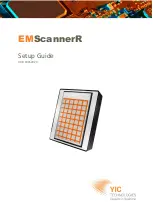
30 seconds leaving LMDT-810 detecting unchanged light and no movement, the
“L” lux setting can be accurately set up (activate from the product IC). When it is
darker than the “L” lux level, LMDT-810 can detect objects. A similar situation
applies for switching from “H” to “M” or “H” to “L” or vice versa, switching
from darker level to brighter level. There is a need to remain unchanged for 30
seconds as described above.
D. Battery Low Indicator
Battery low indicator is positioned inside the sensor lens. If the battery is low, the
indicator flashes after LMDT-810 delay time ends. Within delay time period,
LMDT-810 still works normally until delay time ends.
When the battery is low, the battery indicator starts to flash to inform the user to
replace the battery. When the battery is low (battery low indicator starts to flash),
LMDT-810 does not work until the user replaces the batteries and re-starts.
OPERATION:
A. Code learning:
Place LMDT-
810 in ‘DEL’ mode near to self programming receiver, which it
will work with.
Press learning button of the receiver, LED flashes continuously.
Slide LMDT-
810 learn switch from ‘DEL’ to ‘SET’, LMDT-810 sends code
to receiver.
Receiver connected lamp flashes twice to confirm the learned code. Receiver LED
stops flashing.
B. Set up Delay-off Time Switch (5sec./1min./5min./10min) as option.
(See FUNCTION OF SWITCHES)
C. Set up Lux. Setting Switch (H/M/L) as option.
(See FUNCTION OF SWITCHES).
Note whether there is surrounding light that can influence the brightness and
affect the Lux. setting choice. For example, in the late evening, the lux. setting
is ‘L’. However, if there is a lamp in environments where LMDT-810























